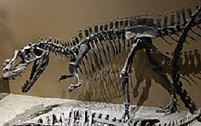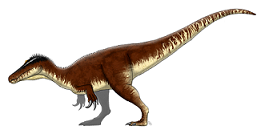
Ostafrikasaurus : Exploring the Enigmatic Predator of Ancient Africa.
In the heart of the Late Jurassic period, a distant corner of the world now known as Tanzania bore witness to the existence of a formidable predator – Ostafrikasaurus. As a member of the theropod lineage, this enigmatic dinosaur has left its mark on the annals of paleontology, offering a tantalizing glimpse into the diverse ecosystems that once thrived on the African continent.
Ostafrikasaurus emerged from the depths of time through the discovery of fossil remains, a puzzle of ancient bones and fragments that have been carefully pieced together to unveil a creature from the past. The name Ostafrikasaurus" pays homage to its origin in East Africa, reflecting its significance in shedding light on the Mesozoic history of the region.
| Name: | Ostafrikasaurus dinosaurs |
| Size: | Around 10.3 meters long and weighing about 2-3 tons. |
| Main Facts : | Ostafrikasaurus is a carnivorous theropod dinosaur known from limited fossils, shedding light on Late Jurassic African ecosystems. |
While our understanding of Ostafrikasaurus is based on incomplete fossil evidence, its classification as a theropod places it among the ranks of bipedal, carnivorous dinosaurs. These predators, characterized by sharp teeth and grasping claws, played a crucial role in shaping ancient ecosystems as top predators.

Ostafrikasaurus likely possessed a combination of features that aided it in its predatory lifestyle. While specific details remain speculative, its strong hind limbs and sharp claws suggest adaptations for swift movement and capturing prey. Its skeletal structure, including vertebrae and limb bones, provides insights into its physical capabilities and possible hunting strategies.
As a predator, Ostafrikasaurus held a vital ecological role within its ancient African habitat. Its presence would have influenced the distribution and behavior of other organisms in the ecosystem, contributing to the intricate balance of predator-prey relationships.
While the exact nature of Ostafrikasaurus's prey is a subject of speculation, its carnivorous nature implies that it would have hunted other animals. Small to medium-sized herbivorous dinosaurs and other vertebrates would have been potential targets. Its hunting strategies might have involved ambushing or pursuing prey using its sharp claws and teeth.
Ostafrikasaurus provides a snapshot of the complex interactions that defined ancient African ecosystems. It existed alongside a diverse array of creatures, each playing a role in the intricate web of life. Studying Ostafrikasaurus contributes to our understanding of how different species coexisted and competed for resources in a dynamic and ever-changing environment.
Despite the fragmentary nature of its fossils, Ostafrikasaurus has made meaningful contributions to the field of paleontology. Its discovery enhances our understanding of the global distribution of theropod dinosaurs and their role in shaping ecosystems across continents.
Ostafrikasaurus, a Late Jurassic theropod from Tanzania, remains partially shrouded in mystery due to limited fossil evidence. Belonging to the carnivorous lineage, it navigated ancient African landscapes as a predator. While its appearance and behavior are not fully understood, its existence adds a crucial piece to the puzzle of prehistoric life on the continent. Sharp claws and teeth hint at its carnivorous lifestyle, likely preying on smaller dinosaurs and other vertebrates.
Despite its fragmented story, Ostafrikasaurus serves as a window into the dynamic ecosystems of ancient Africa, where predator-prey relationships shaped the evolutionary tapestry. Ongoing research continues to unlock its secrets, offering insights into its role within its ecosystem and the evolutionary history of theropod dinosaurs in this region.
Ostafrikasaurus belongs to the Allosauroidea superfamily, which includes a diverse array of theropod dinosaurs. Comparing it to other allosauroids may reveal shared anatomical features, such as the structure of its vertebrae and limbs, providing clues about its locomotion, hunting strategies, and potential prey.
Comparisons with other theropods from the Late Jurassic period, such as Allosaurus and Ceratosaurus, can shed light on Ostafrikasaurus's ecological role and adaptations. Examining similarities and differences in tooth morphology, limb proportions, and other traits can help researchers understand how Ostafrikasaurus fit into its ancient ecosystem.
Ostafrikasaurus contributes to our understanding of the unique dinosaur fauna that inhabited Africa during the Late Jurassic. Comparing it to other African dinosaurs, like the sauropods discovered in the same Tendaguru Formation, provides a more comprehensive picture of the complex interactions that shaped the continent's prehistoric ecosystems.
Comparing Ostafrikasaurus with theropods from other parts of the world can offer insights into how similar adaptations evolved independently in different regions. This comparative approach can help paleontologists identify convergent evolution and highlight the selective pressures that influenced theropod diversity.
As a carnivorous theropod, Ostafrikasaurus can be compared to other meat-eating dinosaurs, such as Tyrannosaurus rex and Velociraptor. While they lived in different times and places, studying their shared characteristics and differences contributes to our understanding of theropod evolution and predatory behaviors.
Comparing the preservation of Ostafrikasaurus fossils with those of other dinosaurs offers insights into the taphonomy of the Tendaguru Formation. Variations in fossilization can provide clues about ancient environments, burial processes, and the conditions that led to the preservation of certain species.
By comparing Ostafrikasaurus with other dinosaurs, researchers can identify trends in body size, anatomical features, and ecological roles over time. These comparisons contribute to our understanding of how dinosaurs diversified and adapted to changing environments throughout the Mesozoic Era.